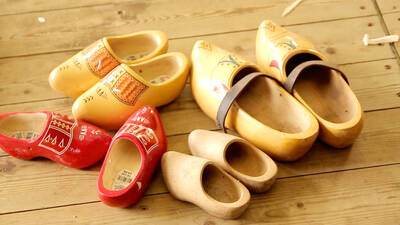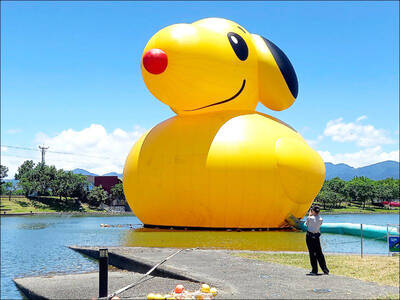If you have ever stared at a light bulb for more than a few seconds, you may have noticed that you could still see an outline of the image for a few seconds after you stopped looking it. The outline you saw is known as an afterimage, or ghost image. In today’s experiment we will take a closer look at afterimages and learn about the features of the eye that cause them.
What you will need: a flashlight, some cardboard and some adhesive tape.(JOHN PHILLIPS, STAFF WRITER)
如果你曾盯著燈泡超過數秒鐘,你可能會發現,即使移開視線,該影像的輪廓仍會浮現在眼前好幾秒。你所見的輪廓就是所謂的「後像」或「殘影」。在今天的實驗中,我們將更進一步了解後像及眼睛產生後像的原理。

PHOTO: AFP
實驗所需:一支手電筒、若干厚紙板和膠帶。
(翻譯:袁星塵)
METHODOLOGY
Step 1: Use the cardboard to block out most of the light from the flashlight. The remainder of the light should make a recognizable shape, like a square, triangle or star.
Step 2: Stare at the flashlight for about thirty seconds. Make sure you use a flashlight with low luminosity, otherwise you could damage your eyes.
Step 3: Look at a wall. You should notice that the afterimage persists for a few seconds.
Step 4: Hold up your hand and look at it. You will see the afterimage on your hand and it will appear larger than when it was on the wall.
Step 5: Cover your left eye and stare at the flashlight with your right eye. Uncover your left eye and look at the wall and you will see the afterimage. However, when you cover your right eye you won’t see an afterimage.
方法
步驟一:用厚紙板擋住手電筒大部分的光源,讓剩下的部份變成可辨認的形狀,例如:正方形、三角形或星形。
步驟二:注視手電筒約三十秒。務必選用低光度的手電筒,否則你的眼睛可能會受傷。
步驟三:盯著一面牆看,你會看見後像在牆上存留數秒。
步驟四:把手舉起來,然後注視著它。你會在手上看到後像,而且它會比在牆上時來得大。
步驟五:遮住左眼,只用右眼注視手電筒的光線。鬆開手用兩眼一起注視牆壁,你會看到後像;可是當你遮住右眼時,你就看不到後像了。
HOW IT WORKS
Your retina works in the same way as photographic paper. When it is exposed to light, the light creates an image on it. This image is then relayed to the brain. When you stare at a bright light for a long time, the photosensitive cells in your retina desensitize to the brightness and stop working as efficiently. When you look at the wall, the desensitized cells create a temporary silhouette. After a few seconds, they readjust and you see the wall normally.
In step 5, the reason you could only see the afterimage in the uncovered eye is because it occurs at the point of input (the retina) and not the point of process (the brain).
實驗原理
視網膜的功能就像照相機的底片,當暴露於光線下時,光線會在其上產生影像,然後這個影像會被傳送至大腦。長時間注視發亮的光源會使視網膜上的感光細胞敏銳度減低,無法繼續有效作用。當你注視牆面,這些敏銳度減低的細胞會產生暫時性的黑色輪廓像。數秒後,它們會重新調整,你的視覺便又恢復正常了。
在步驟五中,之所以只有被遮住的那隻眼睛可以看到後像,是因為後像是在輸入位置(視網膜)而非處理位置(大腦)產生。

A: The news says comic superstar Snoopy’s birthday is coming soon on Aug. 10. B: So he’s a Leo, and his birthday will fall on this Sunday. A: Cartoonist Charles Schulz created the comic strip Peanuts, featuring Snoopy, in 1950. And this year marks the character’s 75th anniversary. B: No wonder there are some big celebrations in Japan, Hong Kong and elsewhere. How about Taiwan? A: The “How Do You Do, Snoopy?” exhibition is taking place in Taipei. Let’s go to Shin Kong Mitsukoshi Department Store’s A11 branch to see the show. A: 新聞說,卡通巨星史努比的生日是8月10日耶。 B: 原來史努比是獅子座,本週日就是他的生日。 A: 漫畫家查爾斯舒茲1950年在《花生》漫畫創造了該角色,今年正好歡慶75週年! B:

When you think of the Netherlands, images of tulips, windmills, and iconic wooden shoes — known as “Dutch clogs” — may come to mind. These traditional shoes are rich in cultural significance. For centuries, Dutch clogs have been admired for their sturdy design and impressive craftsmanship, making them a fascinating symbol of Dutch heritage. Dutch clogs date back to the Middle Ages. During that time, farmers and laborers needed durable shoes to cope with the region’s damp and unpredictable climate and topography. Crafted from solid wood, such as willow or poplar, clogs offered outstanding protection. Their firm structure kept

A: Apart from the “How Do You Do, Snoopy?” exhibition, the Penghu International Fireworks Festival displayed some Snoopy-themed balloon installation art. B: The Yilan International Children’s Folklore & Folkgame Festival also displayed a giant rubber “Snoopy Duck.” A: And Starbucks, Kura Sushi and 7-Eleven are all selling Snoopy-themed products. B: Starlux Airlines even launched new Snoopy-themed flights recently. Isn’t that cool? A: Taiwanese love Snoopy so much. Happy 75th birthday, Snoopy. A: 除了《How Do You Do, Snoopy?花生漫畫75週年特展》,澎湖海上花火節展出了史努比氣球裝置藝術。 B: 而宜蘭國際童玩藝術節,則展出了巨型「史努比鴨」。 A: 星巴克、藏壽司、7-Eleven也推出了史努比聯名商品。 B: 星宇航空今年更推出全新「Snoopy主題航班」,很酷吧? A: 台灣人好愛史努比啊,75歲生日快樂!

Whale sharks are the largest species of fish in the world. They aren’t related to whales, but take their name due to their enormous size. At full maturity, whale sharks measure around nine or 10 meters long and can weigh from 15,000 to 40,000 kilograms. Whale sharks live in warm waters, with about 75% of them found in the Indo-Pacific region. They can migrate thousands of kilometers to different feeding grounds, but at a slow speed of 5 km/h on average. Whale sharks have a broad, flat head and are typically brown or gray in color. Their distinguishing characteristic